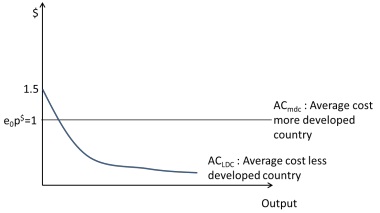Assignment:
I. Ricardian model of trade
Consider that case of There are two Countries: North (N) and South (S). There are two commodities: Computers (C) and Rice (R).
? Inputs to Produce 1 computer: 15 hours in N vs 20 hours in S.
? Inputs to Produce 1 sack of rice: 10 hours in N vs 40 hours in S
a) Produce a graph that demonstrates country N's aggregate production in a case where the relative price of computers to rice is less than 3/2. Describe what your graph is showing.
b) Produce a graph that demonstrates country N's aggregate production in a case where the relative price of computers to rice is greater than 3/2. Describe what your graph is showing.
c) Compute the autarky relative price of computers in S (assume that they do not consume only one good).
d) Given the results above, if both goods are consumed, once the economies are open to trade, what is the range of possible values for the relative price of computers to rice. Why?
e) Assume the relative world price under trade is 3/2. Does N benefit from trade? Why?
II. Production subsidy vs. tariff
A country is considering a tariff or a production subsidy to protect a domestic industry from imports.
a) Assuming the production subsidy is the same % as the tariff, which policy is preferable if we consider only the dead-weight loss? Draw graphs that support your argument.
b) If the policy-maker's only concern is redistributing gains from trade (not an infant industry argument), identify one other policy she could pursue? In 1 or 2 sentences explain how that policy achieves the stated goal.
III. Environmental leakage
A country is a net exporter of a good whose production generates pollution (e.g., negative externality in production).
a) Draw a graph that illustrates production under both autarky and trade assuming no environmental regulations are in place. Identify:
i. NSG from trade
ii. NSG from pollution
iii. Aggregate NSG
b) Based on your results in part (a), can trade be welfare-reducing if there are no environmental regulations? What would need to be true for trade to be welfare reducing?
c) Is it possible for trade in this good to be welfare-reducing if there is an environmental regulation that fully accounts for the welfare costs of pollution? Provide a 1 sentence explanation of why or why not.
Now consider a different good where the country is a net importer and there is a negative externality in the consumption of that good (e.g., smoking). See example below.
d) Draw a graph that illustrates production under both autarky and trade assuming no regulations are in place to address the externality. Identify:
i. NSG from trade
ii. NSG from pollution
iii. Aggregate NSG
IV. International finance and ISI
Assume you are advising the government of a developing country A. The economic consultants explain to the president that there is very little industry in that country because of an infant industry problem, as depicted below:

a) One of the advisors suggests devaluing the currency so that e1 = 2e0. Draw on the graph how that would shift the cost curves (assume no inputs are imported in this industry).
b) Is this a viable plan to develop country A's industry? Yes/No and why, explain briefly.
V. Currency appreciation
a) In an economy where some goods or services are non-tradable, how can an export boom in one sector negatively impact other sectors. Use a graph to illustrate your point?
b) Explain briefly one possible policy remedies for "Dutch Disease" as described above.